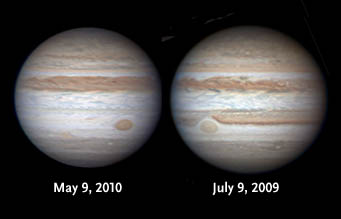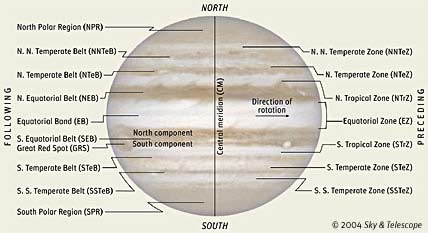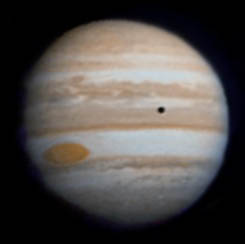When you look at Jupiter through even a small telescope, it's easy to spot the parallel pair of "racing stripes" that straddle its equator. These dusky brown ribbons are known as the North and South Equatorial Belts (NEB and SEB), while the bright "filling" between them is the broad Equatorial Zone. (If you sometimes get confused figuring out which is which, just remember that most or all of the belts hanging in your closet are dark.)

Recently observers were surprised to find that Jupiter's South Equatorial Belt has completely disappeared in the past 10 months — leaving the Great Red Spot quite easy to glimpse. Click here for a larger view of this comparison.
Anthony Wesley
This Oreo-cookie arrangement is how Jupiter looks normally — but not right now. When the King of Planets reemerged in February from its conjunction with the Sun, amateur observers realized right away that something was different. The SEB was missing! Was the planet in upheaval? Had another collision with interplanetary debris taken place? Did aliens sneak in and apply 10 million billion gallons of ceiling paint?
Rest easy, dear readers. Located between roughly –8° and –20°, the broad South Equatorial Belt has a history of vanishing every now and then. According to John Rogers, who coordinates Jupiter observations for the British Astronomical Association, this is the SEB's 17th disappearance since 1901 and the first since 1992-93. (A major disturbance occurred in 2007, but the belt didn't disappear outright as it has now.)
"Many Jupiter watchers noticed the SEB starting to fade late last year," notes observer Anthony Wesley, who tracks the planet and its dynamic activity with a 14½-inch f/5 reflector from Murrumbateman in New South Wales, Australia. So he wasn't surprised that the belt had waned even more once Jupiter returned to view after ducking behind the Sun for about three months. "But this time round it looks like the SEB has faded away completely." Moreover, the corresponding North Equatorial Belt seems broader and darker than usual.

Although Jupiter sports many dark belts and bright zones, the North and South Equatorial Belts (NEB and SEB) stand out most prominently in a telescope. The planet's rotation causes features to move from east (following) to west (preceding).
You would think, after centuries of telescopic study and house calls from seven camera-equipped spacecraft, that planetary scientists would understand the weather patterns on Jupiter. Well, they don't. It's a complicated place. Probably, but not certainly, the zones are bands of upwelling gas that cool as they rise, causing ammonia (NH3) to condense as bright clouds. The belts, conversely, mark where the upper atmosphere is descending to warmer levels; this causes the whitish ammonia clouds to evaporate, revealing dark-hued aerosols lying deeper down.
Whatever the underlying cause(s), the SEB hasn't gone for good. If past events are any guide, a "revival" should begin within the coming year. First there'll be an outbreak of intensely white spots — most likely towering thunderstorms — that will churn the upper atmosphere. During 1993's return, this "SEB Disturbance" appeared quite near the Great Red Spot. Will that be the case this time as well?

Jupiter's South Equatorial Belt was nearly absent during Pioneer 10's flyby of the planet on December 3, 1973. (The black dot is Io's shadow.)
NASA
Both amateurs and professionals are eager to find out. "Having this event occur now is fortuitous," notes Amy Simon-Miller (NASA-Goddard Space Flight Center, "as we have modern instruments and can hopefully shed some light on the cause."
"We're all watching closely to see when the SEB revival will start," adds Wesley. "It promises to be especially dramatic this time."
If you want to keep track of the activity on Jupiter, as seen through the telescopic "eyes" of top amateur observers, check out Wesley's website, Christopher Go's website, this newsletter from the Association of Lunar and Planetary Observers, and recent posts about solar-system imaging on CloudyNights.com.
You can also listen to my May 23rd interview with Guy Raz of National Public Radio's All Things Considered.
By the way, this would be a great time to observe the Great Red Spot, which bobs along at nearly the same latitude as the SEB. With the surrounding clouds temporarily washed out, the spot's dark coloring stands out especially well. You can use our handy online utility to calculate when the GRS appears in the middle of Jupiter's disk, or consult this table of GRS transits compiled by Tony Flanders.
 4
4









Comments
Marc
May 18, 2010 at 1:08 pm
"Jupiter's South Equatorial Belt was nearly absent during Pioneer 10's flyby of the planet on December 3, 1973." But, looking at the picture, the whole arrangement of dark belts and light zones was different. Is the dark belt at the equator the "equatorial belt" at that moment?
You must be logged in to post a comment.
David Fried
May 28, 2010 at 3:37 pm
"One of the giant planet's signature bands. . . " Yes, I've been a fan of their music forever! First heard them at the legendary Music of the Spheres Festival in '69, standing in the methane rain. Looking forward to an article on their nasty split from North Equatorial Belt. Still hoping for reunion concert.
Sorry, couldn't help myself.
You must be logged in to post a comment.
Josh Barnes
June 3, 2010 at 10:04 pm
Visually, with a 15-inch 'scope, I have the impression the South Polar Region is a good bit darker than it looked last year. I'm also seeing a distinctly bluish tint to the Equatorial Band and and the region where the SEB used to be. I'm not sure if these regions have really changed, or if it's a contrast effect...
You must be logged in to post a comment.
Josh Barnes
June 4, 2010 at 1:04 am
Visually, with a 15-inch 'scope, I have the impression the South Polar Region is a good bit darker than it looked last year. I'm also seeing a distinctly bluish tint to the Equatorial Band and and the region where the SEB used to be. I'm not sure if these regions have really changed, or if it's a contrast effect...
You must be logged in to post a comment.
You must be logged in to post a comment.